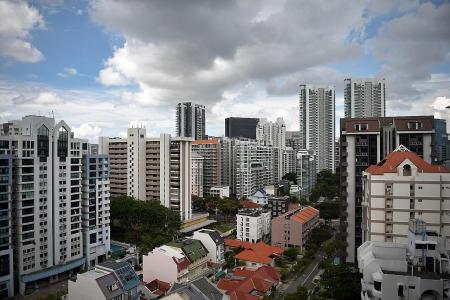URA cuts number of units allowed to be built in pivate flats, condos
Changes aimed at reducing potential strain on infrastructure
From early next year, the maximum number of units allowed in new private flats and condominium developments outside the central area will be reduced, as the Urban Redevelopment Authority (URA) has revised its guidelines in a bid to manage potential strains and stresses on infrastructure.
The new guidelines, announced yesterday, will further curb the proliferation of shoebox units. They will apply to new development applications for projects submitted on or after Jan 17, 2019.
Under new rules, the maximum number of housing units allowed in a development outside the central area will be arrived at by dividing the proposed building gross floor area (GFA) by 85 sq m. The current formula divides GFA by 70 sq m.
This means around 18 per cent fewer units will be allowed, if developers maximise their quota.
Meanwhile, nine areas will face even more stringent requirements where the GFA will be divided by 100 sq m to work out the maximum number of units that can be built. This is to avert a severe strain on infrastructure.
The areas are Marine Parade, Joo Chiat-Mountbatten, Telok Kurau-Jalan Eunos, Balestier, Stevens-Chancery, Pasir Panjang, Kovan-How Sun, Shelford and Loyang. Currently, only four areas - Telok Kurau, Kovan, Joo Chiat and Jalan Eunos - face the tougher guidelines.
URA first introduced guidelines in 2012 to rein in tiny units. Then-National Development Minister Khaw Boon Wan had pointed out in a blog that the Telok Kurau area had experienced "a rampant development of tiny shoebox units" resulting in severe traffic congestion, shortage of car park spaces and double-parking.
Yesterday's tightening came amid concerns over smaller unit sizes in new private housing projects, and that "the number of redevelopments in certain locations may strain infrastructure".
Ms Goh Chin Chin, URA's group director for development control, noted: "This will also encourage developers to provide a more balanced mix of unit sizes to cater to the diverse needs of homebuyers, including large families."
Meanwhile, after once encouraging developers to provide balconies to residents, URA has addressed feedback that some balconies are "oversized" and that some homebuyers find it challenging to find units without balconies.
From Jan 17 next year, the bonus GFA cap for private outdoor spaces will be reduced from 10 per cent to 7 per cent, while the total balcony area for each unit will be capped at 15 per cent of the nett internal area.
The URA also introduced a new bonus GFA scheme to encourage developers to provide more indoor recreation space such as gyms, libraries, function rooms and reading rooms to residents. The new scheme provides bonus GFA capped at 1 per cent of total area (or the GFA of the residential component for mixed-use developments).
Savills Singapore senior director of research and consultancy Alan Cheong believes the new rules aim to address a potential oversupply of units that could have come on collective sales sites.
Taken collectively, analysts say the guidelines favour homebuyers as they are likely to result in larger unit sizes, and possibly lower average selling price (in per square foot terms).
Get The New Paper on your phone with the free TNP app. Download from the Apple App Store or Google Play Store now


